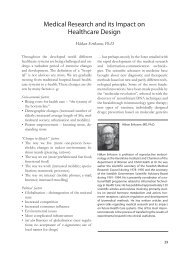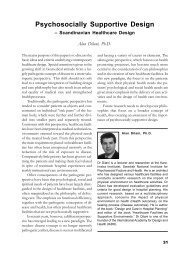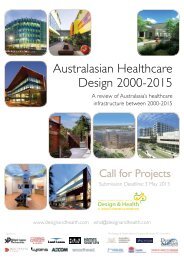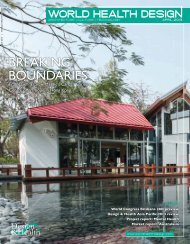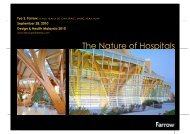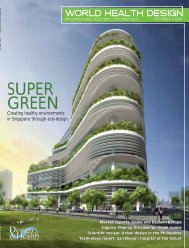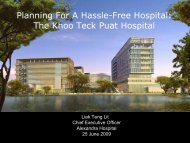RESTORATIVE SpAcE - the International Academy of Design and ...
RESTORATIVE SpAcE - the International Academy of Design and ...
RESTORATIVE SpAcE - the International Academy of Design and ...
Create successful ePaper yourself
Turn your PDF publications into a flip-book with our unique Google optimized e-Paper software.
<strong>Design</strong> & Health Scientific Review<br />
Post-occupancy Evaluation<br />
Figure 11: OHSU-CHH north <strong>and</strong> south green ro<strong>of</strong> <strong>and</strong> cool ro<strong>of</strong><br />
<strong>of</strong>fered an interesting quasi-experimental<br />
setting for our study. Due to <strong>the</strong> variation<br />
in slope compositions <strong>and</strong> layering details<br />
<strong>of</strong> both systems towards <strong>the</strong> primary<br />
drainage point, <strong>the</strong> moisture content <strong>of</strong><br />
20 square feet <strong>of</strong> green ro<strong>of</strong> <strong>and</strong> cool ro<strong>of</strong><br />
were monitored using an established grid<br />
system. The moisture content changed over<br />
a one-month period <strong>and</strong> <strong>the</strong>se findings<br />
were mapped to determine if <strong>the</strong> ro<strong>of</strong> was<br />
functioning efficiently. Fur<strong>the</strong>rmore, <strong>the</strong>se<br />
findings may also help underst<strong>and</strong> which<br />
species <strong>of</strong> plants grow best with respect<br />
to moisture content as well as pinpoint<br />
whe<strong>the</strong>r moisture content helps stimulate<br />
invasive species on green ro<strong>of</strong>s.<br />
A key aspect <strong>of</strong> a well performing<br />
green ro<strong>of</strong> is <strong>the</strong> reduction <strong>of</strong> surface<br />
temperature 21,22 . Looking at <strong>the</strong> ro<strong>of</strong> plan <strong>of</strong><br />
<strong>the</strong> OSHU building, <strong>the</strong>re are two distinct<br />
sections <strong>of</strong> green ro<strong>of</strong>s: one upper ro<strong>of</strong> with<br />
sou<strong>the</strong>rn sun exposure <strong>and</strong> one lower ro<strong>of</strong><br />
with nor<strong>the</strong>rn sun exposure. For our study,<br />
we measured <strong>the</strong> heat reduction capacity<br />
<strong>of</strong> <strong>the</strong>se two areas. We collected our data<br />
from four points: sou<strong>the</strong>rn green ro<strong>of</strong>;<br />
sou<strong>the</strong>rn cool ro<strong>of</strong>; nor<strong>the</strong>rn terrace ro<strong>of</strong><br />
garden; <strong>and</strong> nor<strong>the</strong>rn terrace tiles. These<br />
points were chosen to give an accurate data<br />
reading <strong>of</strong> <strong>the</strong> surface while eliminating as<br />
many outside variables as possible, such as<br />
shade, sun <strong>and</strong> mechanical equipment.<br />
In addition to finding whe<strong>the</strong>r or not <strong>the</strong><br />
green ro<strong>of</strong> aided in surface temperature<br />
moderation, we also wanted to determine<br />
<strong>the</strong> stratification that occurred within <strong>the</strong><br />
layers <strong>of</strong> <strong>the</strong>se ro<strong>of</strong>s, to help establish an<br />
underst<strong>and</strong>ing <strong>of</strong> <strong>the</strong> different microclimates<br />
that occur within each type <strong>of</strong> ro<strong>of</strong>. To<br />
accomplish this, a series <strong>of</strong> sensors were<br />
placed at <strong>the</strong> green ro<strong>of</strong> location as well as<br />
<strong>the</strong> green terrace location. On <strong>the</strong> green<br />
ro<strong>of</strong>, a sensor was placed on <strong>the</strong> surface <strong>of</strong><br />
<strong>the</strong> growing medium under <strong>the</strong> canopy <strong>of</strong><br />
<strong>the</strong> sedum, <strong>and</strong> a sensor was <strong>the</strong>n placed<br />
an inch within <strong>the</strong> growing medium. At <strong>the</strong><br />
green terrace location, a sensor was placed<br />
on <strong>the</strong> surface <strong>of</strong> <strong>the</strong> growing medium<br />
underneath <strong>the</strong> vegetation canopy <strong>and</strong> a<br />
sensor was placed an inch into <strong>the</strong> growing<br />
medium. Additionally, a sensor was placed<br />
approximately 18 inches above <strong>the</strong> surface<br />
in <strong>the</strong> vegetation canopy.<br />
In addition to mitigating <strong>the</strong> urban heat<br />
isl<strong>and</strong> effect, green ro<strong>of</strong>s have excellent<br />
time-lag properties, which help moderate<br />
heating <strong>and</strong> cooling loads on a building 20, 22 .<br />
Focusing on <strong>the</strong> highs over <strong>the</strong> study day<br />
period, our data shows that <strong>the</strong> greenro<strong>of</strong><br />
surface averaged 2.2ºC lower during<br />
<strong>the</strong> day than <strong>the</strong> cool ro<strong>of</strong> surface. When<br />
comparing <strong>the</strong> performance on <strong>the</strong> low<br />
night temperature, <strong>the</strong> green-ro<strong>of</strong> surface<br />
averaged 0.6ºC higher during <strong>the</strong> night than<br />
<strong>the</strong> cool ro<strong>of</strong> surface (Figure 12).<br />
Temperature fluctuations on <strong>the</strong> south<br />
ro<strong>of</strong>s were much more dramatic than<br />
<strong>the</strong> north ro<strong>of</strong>s. The average surface<br />
temperature fluctuation <strong>of</strong> <strong>the</strong> green terrace<br />
was 25 percent less than <strong>the</strong> south-exposed<br />
green-ro<strong>of</strong> surface. Focusing on <strong>the</strong> highs<br />
over <strong>the</strong> study period, <strong>the</strong> green vegetation<br />
in <strong>the</strong> green-terrace surface averaged 0.6ºC<br />
lower during <strong>the</strong> day than <strong>the</strong> cool tile<br />
surface <strong>of</strong> <strong>the</strong> terrace. When comparing <strong>the</strong><br />
low night temperatures, <strong>the</strong> green-terrace<br />
plantings averaged 1.1ºC higher during <strong>the</strong><br />
night than <strong>the</strong> cool tile surface (Figure 13).<br />
Unlike cool ro<strong>of</strong>s, <strong>the</strong> vegetative surface<br />
area <strong>of</strong> green ro<strong>of</strong>s also absorbs carbon<br />
dioxide <strong>and</strong> filters air pollutants. This can<br />
lead to an improvement in <strong>the</strong> ambient air<br />
quality <strong>of</strong> surrounding areas 23 . Depending<br />
on <strong>the</strong> composition <strong>of</strong> <strong>the</strong> vegetative ro<strong>of</strong><br />
system <strong>and</strong> its surface area, green ro<strong>of</strong>s<br />
may significantly decrease storm water<br />
run<strong>of</strong>f during normal <strong>and</strong> peak events 22 .<br />
Based on local city codes, decreasing storm<br />
water run<strong>of</strong>f may lower fines incurred from<br />
large run<strong>of</strong>f events. In addition, green ro<strong>of</strong>s<br />
increase wildlife habitats <strong>and</strong> provide much<br />
needed green space for urban dwellers 23 .<br />
Their visual <strong>and</strong> physical accessibility can<br />
<strong>of</strong>fer an important aes<strong>the</strong>tic appeal, which<br />
can lead to an increase in property value<br />
<strong>and</strong> <strong>the</strong> marketability <strong>of</strong> <strong>the</strong> building as<br />
a whole 22,23 . Our POE assessment <strong>of</strong> <strong>the</strong><br />
building occupants corroborates this finding<br />
based on questionnaires <strong>and</strong> employee<br />
interviews. While not widely tested, green<br />
ro<strong>of</strong>s may also <strong>of</strong>fer acoustic insulation<br />
depending on <strong>the</strong> composition <strong>of</strong> <strong>the</strong> living<br />
substrate 24 . In some cities, <strong>the</strong>y have been<br />
successfully employed for food production 22 .<br />
Conclusions: shades <strong>of</strong> green<br />
To evaluate <strong>the</strong> effectiveness <strong>of</strong> green strategies<br />
in healthcare buildings, designers need<br />
to establish clear performance goals that<br />
acknowledge both <strong>the</strong> physical performance<br />
<strong>and</strong> <strong>the</strong> impacts on occupants’ wellbeing<br />
<strong>and</strong> comfort. An established process<br />
to ensure fine tuning <strong>the</strong> systems, <strong>and</strong> engaging<br />
<strong>the</strong> occupants in managing <strong>the</strong>m<br />
through feedback loops, is essential, helping<br />
engage occupants in <strong>the</strong> building’s management<br />
<strong>and</strong> ensure it meets design goals.<br />
The main objective <strong>of</strong> this paper is to<br />
provide detailed as well as context-specific<br />
information regarding <strong>the</strong> design, operation,<br />
<strong>and</strong> performance <strong>of</strong> a number <strong>of</strong> innovative<br />
green strategies employed in <strong>the</strong> OHSU-<br />
CHH building. By establishing a comparative<br />
approach between different strategies, <strong>the</strong><br />
study provided an evidence-based guide<br />
to future designs for <strong>the</strong> suitability <strong>and</strong><br />
performance <strong>of</strong> one strategy over o<strong>the</strong>rs.<br />
Green strategies should not be perceived<br />
as “one size fits all” <strong>and</strong> might not be<br />
suitable in all design situations. It is clear<br />
from <strong>the</strong> findings that performance <strong>of</strong> some<br />
strategies can positively impact behaviour in<br />
one condition yet have negative impacts on<br />
o<strong>the</strong>rs. <strong>Design</strong>ers will need to balance pros<br />
<strong>and</strong> cons <strong>of</strong> green systems as <strong>the</strong>y manage<br />
<strong>the</strong> design process. The knowledge provided<br />
will help building designers <strong>and</strong> owners<br />
establish a clear vision <strong>of</strong> <strong>the</strong> impact <strong>of</strong> <strong>the</strong><br />
researched strategies on <strong>the</strong> “triple bottom<br />
www.worldhealthdesign.com WORLD HEALTH DESIGN | January 2012 67



